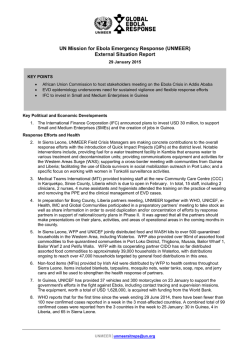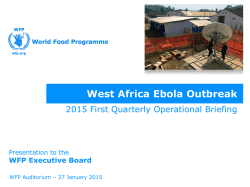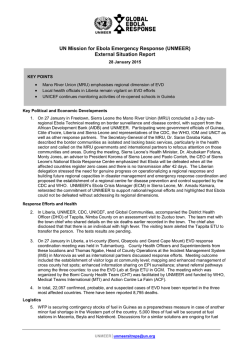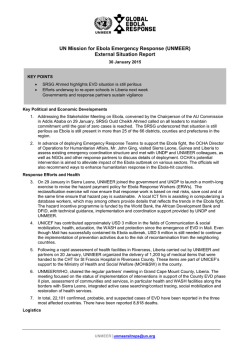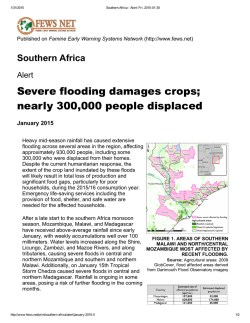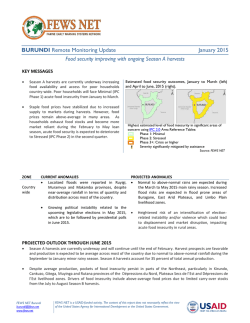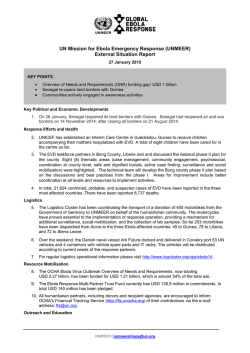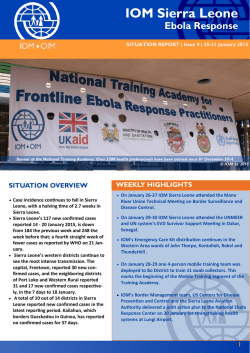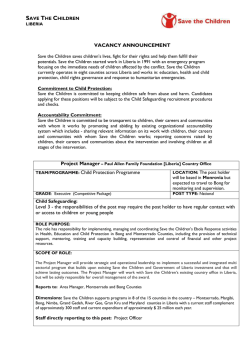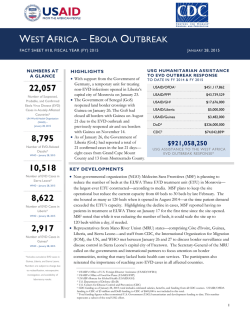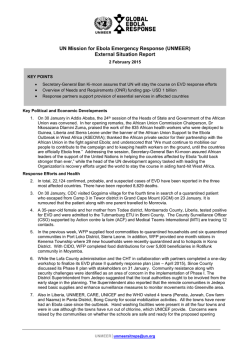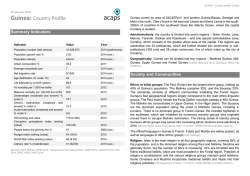
Download PDF
GUINEA, LIBERIA AND SIERRA LEONE Special Report January 31, 2015 Most official movement restrictions lifted, trade flows and market functioning slowly improve Guinea, Liberia, and Sierra Leone are FEWS NET remote monitoring countries. In remote monitoring, a coordinator typically works from a nearby regional office. Relying on partners for data, the coordinator uses scenario development to conduct analysis and produce monthly reports. As less data may be available, remote monitoring reports may have less detail than those from countries with FEWS NET offices. The analysis presented in this report is based on various field information from sources including FEWS NET key informants, a recent SMS-based trader survey conducted by FEWS NET and GeoPoll, and partner information. Figure 1. Projected food security outcomes, January to March 2015 KEY MESSAGES Market functioning and trade flows are still below-normal but are slowly improving across the region compared to previous months due to the lifting of official movement restrictions (Liberia), district-level quarantines (Sierra Leone), and official border closures (across the region, except for Liberia). Despite improving market functioning, household incomes from many typical sources remain below average, causing household purchasing power to remain atypically weak and limiting food access for poor households reliant on market purchases to meet basic needs. As food stocks from recent harvests deplete, the population facing Stressed (IPC Phase 2) and Crisis (IPC Phase 3) food security outcomes is expected to increase in the coming months. CURRENT SITUATION Source: FEWS NET Figure 2. Projected food security outcomes, April to June 2015 Ebola caseload According to the World Health Organization’s January 28th situation report, the number of new Ebola cases has been in decline, particularly in Sierra Leone and Liberia. During the past 21 days, WHO reports that there has been a total of 478 suspected, probable, or confirmed cases across the three countries, with 366 new cases in Sierra Leone, 20 in Liberia, and 92 in Guinea (Figure 3). Agricultural activities Harvesting activities for tubers and early maturing, off-season crops (ex. tomatoes, carrots, cabbage and lettuce), as well as weeding for market gardening crops, are currently ongoing. These activities are currently occurring at normal to slightly below-average levels due to weak household purchasing power for agricultural inputs and reduced incentives to cultivate during the off-season caused by Ebola-related difficulties marketing crops. However, recent and ongoing harvests have contributed to improved food availability and diversity for households and at markets compared to previous months. FEWS NET WEST AFRICA [email protected] www.fews.net Source: FEWS NET This map represents acute food insecurity outcomes relevant for emergency decision-making. It does not necessarily reflect chronic food insecurity. To learn more about this scale, click here. FEWS NET is a USAID-funded activity. The content of this report does not necessarily reflect the view of the United States Agency for International Development or the United States Government GUINEA, LIBERIA AND SIERRA LEONE Special report Household incomes January 31, 2015 Figure 3. Ebola caseload distribution In the three Ebola-affected countries, FEWS NET’s key informants are reporting that incomes from key sources, such as food crop and forestry product sales, agricultural labor, petty trade, and handicraft sales, have improved for most areas compared to previous months but are still at below-average levels due to reduced market functioning and atypically low demand from both traders and non-agricultural households restricted by low purchasing power. Similarly, a ban on bush meat sales has contributed to a significant decline in incomes from this source compared to normal. However, livestock and fish sales are in general relatively average while charcoal production has reportedly intensified to help offset the effects of below-average incomes from other sources. Cell-phone based surveys conducted in November and December 2014 by the Government of Sierra Leone, the World Bank, and Innovations for Poverty Action in Sierra Leone and the World Bank, Liberia Institute of Source: WHO Statistics and Geo-Information Services, and Gallup in Liberia found increased unemployment levels, particularly in urban areas and amongst those employed in wage work and non-agricultural self-employment, compared to reference survey data collected earlier in the year. In Liberia, where three rounds of data had been collected between October and December 2014, those reporting unemployment increased between the three rounds in urban areas and remained relatively stable in rural areas. In addition, the Sierra Leone survey found no difference in employment levels between quarantined and non-quarantined areas. Movement restrictions, trade flows, and market functioning On January 22, the government of Sierra Leone announced that they were lifting district-level quarantines previously in place across the country. Similarly, official population movement restrictions in Liberia were lifted late in the 2014 year. In Guinea, official movement restrictions similar to those imposed in Sierra Leone and Liberia were never put into place. Due to the lifting of quarantines and movement restrictions, as well as reduced fears as the number of new Ebola cases decline, FEWS NET’s key informants are reporting that internal trade flows have mostly normalized in Guinea, and have slowly improved compared to previous months but are still at below-average levels in Sierra Leone and Liberia. With regards to cross-border trade, Liberia’s borders remain officially closed while all other borders with the three Ebolaaffected countries have now reopened. Most recently, the Senegalese government announced in late January that they were re-opening their border with Guinea. However, despite the reopening of most borders, cross-border trade flows continue at reduced levels due to trader fears about frequenting Ebola-affected countries and increased control measures along borders. According to the results of FEWS NET’s bi-monthly, SMS-based trader surveys in Liberia, a larger percentage of traders reported that markets were open and operating normally in early January, suggesting that the decline in Ebola caseload numbers, the lifting of movement restrictions, and reduced fears may be leading to improved market functioning in this country. Meanwhile, in Sierra Leone, a larger percentage of traders reported reduced market functioning in late December and early January (when quarantines were still in place), suggesting that continued restrictions in that country were negatively impacting market operations. Famine Early Warning Systems Network 2 GUINEA, LIBERIA AND SIERRA LEONE Special report January 31, 2015 Figure 4. Status of weekly market activities, as a percentage of total respondents to FEWS NET’s SMS-based trader survey Liberia Week of Nov. 17 Week of Dec. 8 Week of Dec. 22 Week of Jan. 5 Sierra Leone Week of Nov. 17 Week of Dec. 8 Week of Dec. 22 Week of Jan. 5 0% 10% 20% 30% Open and normal activities 40% 50% 60% Open and reduced activities 70% 80% 90% 100% Closed Source: FEWS NET Market prices In Guinea, December prices for local cereals (rice, maize) generally were stable or in decline compared to November levels and below last year’s levels. The largest decline in local rice prices compared to last year was observed in Nzérékoré, located in a surplus-rice producing zone that has been the epicenter of Guinea’s Ebola outbreak. December prices for refined palm oil, yams, Irish potatoes, and rubber are also below last year’s levels across most markets in Guinea. While these low prices will help facilitate household food access for poor, market dependant households, they will also contribute to below-average incomes for agricultural households. December prices for Sierra Leone and Liberia are not yet available. A discussion of the most recently available price data for these countries can be found here. Nutrition Although programmatic data remain sparse, the recent study led by the World Bank, Innovations for Poverty Action, and Statistics Sierra Leone revealed a decline in the utilization of prenatal services in Freetown, which could reflect decreased utilization of other non-EVD related health services. In 2013, 78 percent of urban households with a pregnant women reported attending at least one prenatal visit in the previous two months. However, the survey conducted in November 2014 revealed that this level had dropped to just over 40 percent. Admissions to programs for treatment of severe acute malnutrition in Sierra Leone in late 2014 also remained consistently below historical averages. UPDATED ASSUMPTIONS The current situation has not affected most of the assumptions used by FEWS NET in establishing the most likely food security scenario for December 2014 through June 2015. However, the following assumptions has been updated: Ebola outbreak: In Guinea, Liberia, and Sierra Leone, the rate of new Ebola cases will slow throughout the outlook period although low levels of new cases will continue across the region. Exports to Senegal from Guinea: Due to the recent reopening of the Guinea/Senegal border, potato producers in Labé and Mamou and fruit and tomato producers in Kindia will see improved demand for their products compared to previous months although residual trader fears will still result in slightly lower than usual crop sales during the outlook period. Trade flows in Sierra Leone: Internal trade flows will continue to be below-average but will improve compared to levels during the last quarter of 2014 with the lifting of district-level quarantines. With regards to cross-border trade, some border crossings will open during the outlook period and will favor exchanges between Sierra Leone and neighboring countries compared to December levels, although exchanges will remain below average. Famine Early Warning Systems Network 3 GUINEA, LIBERIA AND SIERRA LEONE Special report January 31, 2015 Food prices in Sierra Leone: Between December and January, prices will remain relatively stable or in decline, particularly in the main agricultural production areas. Starting in February, prices will begin to rise seasonally and will evolve to above average levels between April and June due to atypically strong demand and low food stock levels. PROJECTED OUTCOMES Guinea Most agricultural households will rely on their own crop production from the recent harvest, along with relatively average incomes from agricultural activities, to meet their basic food and non-food needs between January and June and will face Minimal (IPC Phase 1) acute food insecurity. In Nzérékoré and Conakry, however, Ebola-related fears and a general economic slowdown have led to a significant decline in incomes from typical sources (petty trade, labor, transportation, etc.) for both poor, agricultural and non-agricultural households. While they are expected to be able to minimally meet food needs, poor households will have difficulties meeting their non-food expenditures between now and June 2015. In the Kissidougou Prefecture of Farahan, many households will also face similar shocks to incomes and reduced purchasing power, causing Stress (IPC Phase 2) food security outcomes between April and June 2015 In Kindia and Labé, poor households generally earn a significant amount of income from the sale of cash crops (potatoes, tomatoes, and fruits) to Senegal. However, difficulties marketing their products due to the border closure and low demand from Senegal led to a significant decline in household incomes and an increase in debt levels during the last quarter of 2014. While the recent reopening of the Senegal/Guinea border is expected to improve incomes for these households compared to previous months, the residual effects of below-average cash incomes earlier in the consumption year will limit food access once household food stocks deplete. Consequently, poor households in Labé and Kindia are expected to begin facing Stressed (IPC Phase 2) between April and June 2015. Liberia As household food stocks in most areas of the country are relatively similar to a normal year, poor households in agricultural areas will rely on their own crop production to meet food needs in the short-term. However, below-average incomes due to market and trade disruptions and a general economic slowdown will reduce the ability of certain households, particularly market-dependent, non-agricultural households, to afford essential non-food expenditures. Between January and March, areas worst affected by the poor agricultural production and market disruptions (Bomi, Bong, Grand Bassa, Grand Kru, Lofa, Margibi, Maryland, Montserrado, and Sinoe counties) will face the highest levels of food insecurity, although as the year progresses, Stressed (IPC Phase 2) food security outcomes are expected across the country. Sierra Leone Despite the recent lifting of district-level quarantines, income levels through crop sales and non-agricultural activities will remain limited in many areas due to below-average market functioning, border closures, and atypically high unemployment levels. The resulting reduction in household purchasing power will cause poor households in much of the country to be unable to cover essential non-food expenditures and face Stressed (IPC Phase 2) acute food insecurity. In areas where disruptions to agricultural production and market activities have been most severe, such as Kailahun, Kenema, Bombali, Port Loko, and Moyamba, poor households will likely face small to moderate food consumption gaps, equivalent to Crisis (IPC Phase 3) between April and June 2014. Famine Early Warning Systems Network 4
© Copyright 2025
